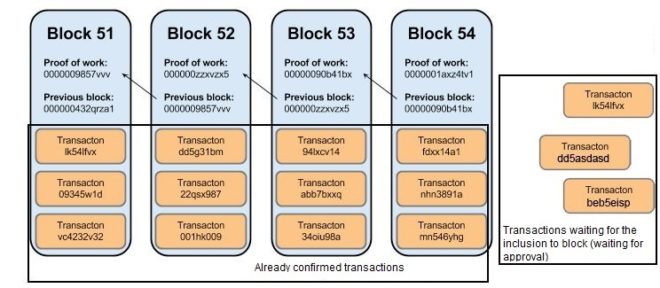
What sense does it make to get such confirmation? Why should you wait for a confirmation given that your payment transaction has already been approved and put in a blockchain? Needless to say that each company defines the number of compulsory confirmations. What if you are selling a thing using bitcoin or another coin? How many confirmations does it require and why? And what if you wait hours while others get their transactions confirmed within 10 minutes?
Blocks forming in a blockchain
The creation of a new bitcoin block takes about 10 minutes. The block is then added to the existing blocks of a bitcoin blockchain. In litecoin, the process take 2.5 minutes. The blocks represent payment transactions made by individual users and verified by miners. You may assume that the transaction should be valid by just being put in the block and added to others. Yet, this is only part of the truth.
Transactions using bitcoin are in general seen as safe after receiving at least 6 confirmations. This means that 5 more blocks will be added after your transaction. Once the transaction is in the block it takes about an hour to receive five confirmations. The crypto-wallets often require the minimum of 3 such confirmations, i.e. the adding of two more blocks.

Blocks in a blockchain and transactions waiting for being confirmed
Why some transactions do not receive confirmation/s?
It’s because of the miners. It’s the miners who verify the transaction and affect the speed at which your transaction travels to the block. The reason for your waiting for the confirmation of a transaction sent an hour ago may be that the miners don’t care. It may also happen that your transaction will never be confirmed.
Never forget to reward the miners!
In most cases, the reason is simple. When sending bitcoins you always have the possibility of affecting the speed and likelihood of processing (certification) of your transaction by adding reward for the miners – miner fee. If your reward is adequately high your transaction will be processed quickly.
If you give the miner a reward that is too small or none (using the option of zero transaction fee) you may wait for your confirmation for hours, days or weeks. No miner will confirm such a transaction because of no profit. Instead, every miner will prefer concentrating on transactions offering some reward. It may also be the bitcoin network that rejects such a transaction and sends money back to your wallet.
Too small or none reward (fee) is the most frequent reason for not processing your transaction. Other reasons for waiting too long may include the following:
- An excessive number of transactions overloading the network.
- Attempted double-spending.
- Attempt to use money displayed as being on your account but not yet confirmed.

A transaction rewarded with 5 satoshi will not be confirmed as the miners prefer higher fee.
If you sent your crypto from an exchange or wallet you don’t have to care about the fee. It will be calculated and assigned to the transaction automatically. This avoids your transaction not to go through the network.
You can assign a higher reward to a pending payment
Even if your transaction gets stuck nothing is lost. You can apologize for not adding any fee and add the fee to your waiting transaction later. This is called fee bumping. This can be done e.g. with the Electrum wallet. Using a service called Replace-By-Fee, this wallet makes it possible for a trader to raise transaction fee while waiting for confirmation.
With the Electrum wallet, you can use the dynamic fee determined with respect to the current supply & demand. This will make sure that your transaction is processed as soon as doable. The downside of it is that you may pay more (for the transaction fee) than necessary.
How big should the transaction fee be?
When considering how much you should pay the miners to make sure that your transaction is processed as quickly as possible, look for some inspiration here. The table also shows how many transactions have been processed and how many are sitting in a queue depending on the assigned transaction fee. The default transaction fee is expressed in the smallest unit of the bitcoin, Satoshi. However, you can set it up for bits, mBTC or BTC.
No confirmation – no transaction
Executing a transaction does not necessarily mean that the transaction will take place. The same applies to the recipient. If somebody sends money to your account is something you see immediately: Until the transaction gets confirmed, the money is not yours. So, if someone uses crypto for buying a from you some item you should wait until the transaction is confirmed. If you are not patient enough and send the item without waiting for the confirmation, the combination of several unfavorable factors may end up having neither the goods, not the bitcoins.
With the above in mind, when withdrawing coins from bitcoin ATMs it’s often necessary to wait for the confirmation and get back a few minutes later.
How to recognize a confirmed transaction
Once you have executed the transaction your crypto-wallet or exchange should enable you to see the transaction through block explorer or display transaction ID. The structure of this number identifying each transaction may be as follows:
7a43510932e143b7078851ef0a5a5c3625db37541861dd982f56253b2d5c4ff9.
Copy this number into the block explorer and press „SEARCH“. The system will display a protocol in which you will see how many confirmations your transaction has received so far.
If your transaction has received at least one confirmation it means that the block carrying your transaction will be added to the rest of the blocks in the blockchain. One may say that the depth of the mine is one block. Each new block with your transaction added to the blockchain will help you dig deeper by one block.
Websites to explore transactions in the Bitcoin network:
To make sure that your transaction has been completed successfully you should wait for more blocks to confirm your transaction (be added after your transaction). The deeper the block containing your transaction lies, the better for you. Given that the creation of a bitcoin block takes on average 10 minutes, the time you have to wait is acceptable.
How many confirmations a transaction needs
- If you didn’t receive a single confirmation for a particular transaction you must wait.
- If the system displays one confirmation for a transaction this is enough to make a small BTC payment not exceeding USD 1 000.
- Three confirmations for one transaction is pretty sufficient (most traders wait until they receive 3 confirmations). In general, three confirmations are seen as absolutely sufficient for the range from USD 1 000 to USD 10 000.
- Six confirmations are seen as adequate for large payment transactions worth USD 10 000 to USD 1 000 000.
- Transactions whose value exceeds USD 1 000 000 should be backed by 60 confirmations. It’s not a problem if the figure is lower but “for sure”.
Why wait for more confirmations if a transaction has already been put in a block?
By the existing rules, the transaction should no longer be returned or removed. Is it true? Well, it is but not entirely. When mining bitcoins two different miners may identify two correct solutions simultaneously. Let’s call these solutions to block A and block B. If this unlikely situation occurs the network will split into two and each part will work with a different blockchain version differing in the last block (one end of the blockchain is A and the opposite one is B). Both blocks offer the correct solution. The problem is that now you have two blockchains, which can’t stay this way. There must be one blockchain only.
Now it all depends on the next block to be solved. Let’s call it to block C. Block C is coming up with a correct solution linked either to block A or block B. If the correct solution of block C is linked to block B block A will die. The software will continue working with the longer branch, in our case the branch with block C at the end. If your transaction is sitting in block A (which died as described above) the transaction will not take place. This situation should be a warning for all who don’t patiently wait until they have received a sufficient number of confirmations.



